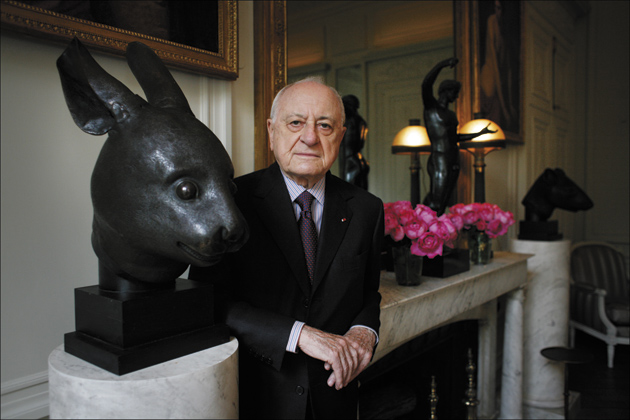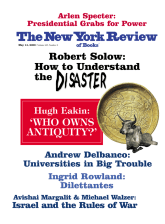The two bronzes—depicting the head of a rat and the head of a rabbit —were designed by the Italian Jesuit missionary Giuseppe Castiglione for the Qianlong Emperor in the mid-eighteenth century, and belonged to several European collections before they were acquired by Pierre Bergé and the late Yves Saint Laurent in the 1990s. They were originally part of a rococco clepsydra, or water clock, that featured the twelve animals of the Chinese zodiac and was affixed to a pavilion inspired by Versailles.
Though of Western design, the ensemble had been created for the Old Summer Palace near Beijing, whose looting and destruction in 1860 by Anglo-French forces (led by General Cousin-Montauban and the eighth Lord Elgin, whose father acquired marbles from the Parthenon) has become a symbol of national humiliation for the Chinese.
At the end of Qianlong’s reign, the Manchu court seems to have lost interest in Castiglione’s European architecture and in 1795 ordered the pipework of the fountain to be melted down. But the zodiac heads remained in place; they were looted during the 1860 invasion and some of them have circulated on the international market ever since.
In recent years, Chinese buyers —including the Poly Group, a commercial arm of the People’s Liberation Army—have aggressively bid for other bronze heads from the same fountain, reclaiming the ox, tiger, monkey, pig, and horse for China; the horse head, which had sold for $367,000 in 1989, went for $8.9 million in 2007 to Stanley Ho, a billionaire Macau and Hong Kong–based casino developer, who donated it to China. When the rat and rabbit were offered at the Christie’s auction of the Yves Saint Laurent collection in Paris in February, a Chinese advocacy group unsuccessfully attempted to block the sale in a French court; on February 25, an anonymous buyer made a winning bid of 31.4 million euros (about $40 million) for both. Several days later, the buyer revealed himself as Cai Mingchao, a Chinese businessman and art dealer, but announced that he had no intention of paying for them; he maintained that they should be voluntarily returned to China.
The Chinese government has officially distanced itself from the false bid, although Cai is an adviser to China’s National Treasure Fund, a government organization that supports the repatriation of Chinese artifacts, and he has been widely praised as a “patriot” in the Chinese press. Pierre Bergé, while noting that China does not have any legal claim to the objects, has meanwhile offered to return them to China if the Chinese government “gives in return human rights, the liberation of Tibet, and a welcome for the Dalai Lama.”
The controversy has been of some concern to the French government, which has been trying to expand its economic ties with China. According to a March 26 report in the French magazine Le Point, Jean-David Levitte, the diplomatic adviser to French President Nicolas Sarkozy, had raised the possibility of bringing together a consortium of French companies that do business with China, including the supermarket and retail giant Carrefour, to put up the money for the bronzes and donate them to the Chinese government. Another possibility is that they could be offered to the second-highest bidder in the Christie’s auction. For now, the objects remain in the collection of the Pierre Bergé–Yves Saint Laurent Foundation in Paris.
—April 15, 2009
SOURCES DRAWN ON FOR THIS REPORT
“Pierre Bergé: ‘Le jour où la Chine deviendra indiscutablement une démocratie…,'” interview with La Grande Époque, April 9, 2009, available at www.lagrandeepoque.com/LGE/content/view/6183/104.
Emmanuel Berretta, “Carrefour et l’Élysée veulent racheter les bronzes chinois,” Le Point, March 26, 2009.
Cécile and Michel Beurdeley, Giuseppe Castiglione: A Jesuit Painter at the Court of the Chinese Emperors, translated from the French by Michael Bullock (Tuttle, 1971).
Richard Kraus, “When Legitimacy Resides in Beautiful Objects: Repatriating Beijing’s Looted Zodiac Animal Heads,” in State and Society in 21st-Century China, edited by Peter Hays Gries and Stanley Rosen (RoutledgeCurzon, 2004), pp. 195–215.
Zhang Lei, “Patriotic Bidder Thwarts Relics’ Sale,” China Daily, March 3, 2009.
Rosemary Scott, “Les têtes en bronzes du Palais d’été de l’empereur Qianlong,” in Collection Yves Saint Laurent et Pierre Bergé, Vol. V: Sculptures, Objets d’Art, Art d’Asie, Archéologie et Mobilier, catalog for the Christie’s auction, Paris, February 25, 2009.
This Issue
May 14, 2009




